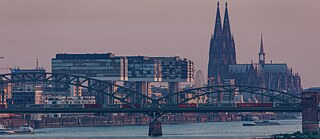Vater Rhein
Köln lies on the Rhine River. The city is regularly affected by flooding from the river and is considered Europe’s most flood-prone metropolis. The 1993 flood caused damages of 100 million dollars. Only several additional inches in the flood peak level would have drowned major parts of the historic downtown necessitating the evacuation of about 100, 000 inhabitants.
Ancient But Very Much Alive
The 2000-year old city was founded by the Romans and is Germany’s oldest major city. Köln is also home to one of Europe’s oldest universities. University of Cologne was established in 1388 and is today Germany’s largest university with an enrollment of 45,000 students.
The Horrors of War
By the end of World War II 95% of Köln’s downtown had been destroyed and its population had fallen from 800,000 to around 40,000. This loss was mainly caused by a massive evacuation of the residents to more rural areas. The reconstruction of the city followed the architectural style of the 1950s. Thus, Köln today is characterized by simple and modest post-war buildings.
A Moving Memorial
In 1993, artist Gunter Demnig created a series of Stolpersteine (“stumbling blocks”) to commemorate Köln’s residents murdered by the Nazi regime. Demnig replaced the ordinary cobblestones on the pavements, putting in their place stones bearing a simple inscription. The stones were put outside the houses of Jews, gypsies and other Nazi victims. More than 5,000 of such memorials can now be found all over Germany.
More Than Just a Church
Köln’s landmark, the “Kölner Dom”, was severely damaged during the war. Work on the church had started in 1248 when the city wanted to build the largest Gothic cathedral of all. Today, with a height of 516 ft the cathedral still dominates Köln.
Köln’s Season to Go Wild
Köln is the only city with five seasons of the year – if you include carnival, the season of the jesters. Karneval is a huge city-wide party where the people of Köln go crazy for five days. The highlight is the grand parade when 140 tons of sweets and 700,000 bars of chocolate are distributed to over one million spectators.
Gay Pride
Another parade attracting close to a million revelers takes place every year on the first weekend of July. The parade is the final event of the Gay Pride festival which also showcases music, political forums and a candle light vigil remembering those with HIV/AIDS.
Reggae in the City
The annual Summer Jam, Europe’s biggest reggae festival, is held on an island on the outskirts of Köln. Since 1996 all the top names of the international reggae scene have played at this happening which attracts more than 30,000 visitors.
Köln’s Ambassadors
Reggae is also part of the repertoire of the a cappella group “Wise Guys”. The quintet is a huge success in the German-language world – and in German classrooms in the United States. The group sings humorous pop songs using elements from rap, reggae and techno, while singing entirely free of musical instruments. The Wise Guys don’t mind poking fun at their hometown and its local soccer club, 1. FC Köln.
The Local Hero
1. FC Köln drives its fans crazy. In the 1960s one of Germany’s dominating teams it was the first ever Bundesliga champion in the league’s inaugural 1963-64 season. Lately though the club has bounced between the first and second division. But as long as the cathedral stands and there is soccer being played, the loyal fans flock to the RheinEnergieStadion even after local hero Lukas Podolski decided to play abroad.
The Talking Beer
The word “Kölsch” refers to the local dialect and the local beer – the only language you can drink! Kölsch is one of the palest German beers made. The Kölsch appellation is recognized by the German government, which means that only about two dozen breweries in Cologne may legally call their beers Kölsch.
The Water of Cologne
The world’s oldest existing perfume was created in 1709 by an Italian expatriate living in Köln. Giovanni Farina wrote to his brother: “I have found a fragrance that reminds me of an Italian spring morning, of mountain daffodils and orange blossoms after the rain.“ He named his fragrance Eau de Cologne, (Kölnisch Wasser). Over the course of the last three centuries, only 30 people have been privy to the perfume’s secret recipe.
